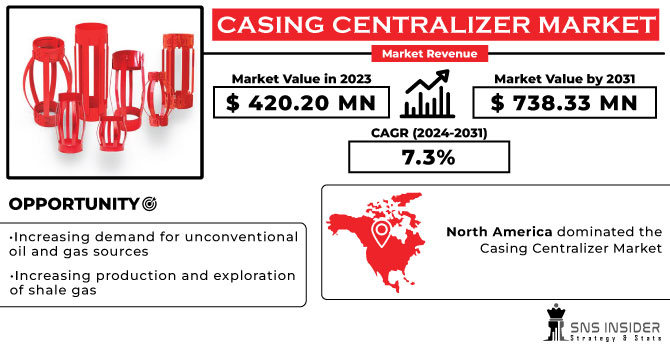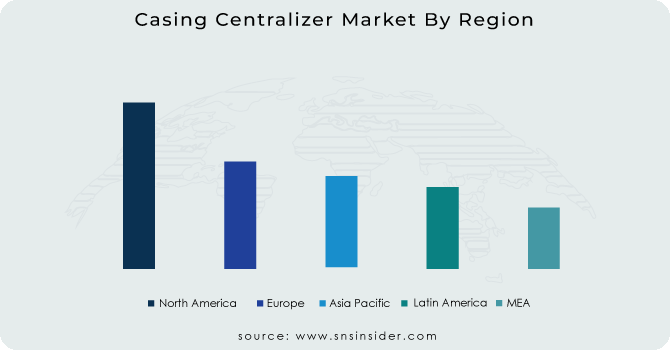Casing Centralizer Market Report Scope & Overview:
The Casing Centralizer Market size was valued at USD 420.20 million in 2023 and is expected to grow to USD 738.33 million by 2031 and grow at a CAGR of 7.3% over the forecast period of 2024-2031.
A casing centralizer refers to a device used in the oil and gas industry to ensure proper placement of the casing in a wellbore. The casing centralizer helps to keep the casing centered in the wellbore, which is important for several reasons. First, it helps to prevent damage to the casing during installation. Second, it helps to ensure that the casing is properly cemented in place, which is critical for well integrity and safety.

Get More Information on Casing Centralizer Market- Request Sample Report
There are several types of casing centralizers available, including bow spring centralizers, rigid centralizers, and composite centralizers. Each type has its own advantages and disadvantages, and the choice of centralizer will depend on the specific well conditions and requirements. Proper use of casing centralizers can help to improve well performance and reduce the risk of well failure. It is important to work with experienced professionals who can help to select the appropriate centralizer and ensure proper installation. The market is highly competitive, with various companies offering different types of centralizers, including bow springs, rigid, and composite centralizers. The demand for casing centralizers is driven by the growth of the oil and gas industry, particularly in regions such as North America, the Middle East, and Asia-Pacific. As the industry continues to evolve, the Casing Centralizer Market is expected to experience significant growth and innovation.
Market Dynamics
Drivers
-
Increasing the number of drilling activities
-
Increasing demand for oil and gas
The Casing Centralizer Market is primarily driven by the rising demand for oil and gas. This demand has led to an increase in drilling activities, which in turn has created a need for efficient and effective casing centralizers. Casing centralizers are devices that are used to keep the casing centered in the wellbore during the cementing process. This is important because it ensures that the cement is evenly distributed around the casing, which helps to prevent any leaks or failures in the well. As the demand for oil and gas continues to grow, the need for casing centralizers will also increase. This is because more wells will need to be drilled, and each well will require multiple casing centralizers. Furthermore, advancements in technology have led to the development of more advanced and efficient casing centralizers. These new devices are designed to provide better performance and reliability, which is essential in the oil and gas industry.
Restraints
-
Volatility in oil and gas prices
Opportunities
-
Increasing demand for unconventional oil and gas sources
-
Increasing production and exploration of shale gas
The expansion of shale gas production and exploration offers a multitude of opportunities for the Casing Centralizer Market. As the demand for energy continues to rise, the exploration and production of shale gas have become increasingly important. Shale gas is a natural gas that is trapped within shale formations deep beneath the earth's surface. The process of extracting shale gas involves drilling deep into the earth and using hydraulic fracturing techniques to release the gas. This process requires the use of casing centralizers, which are devices that help keep the casing centered in the wellbore. Casing centralizers are critical components in the drilling process, as they ensure that the casing is properly positioned and cemented in place. This, in turn, helps to prevent gas leaks and other potential hazards. As the demand for shale gas continues to grow, so too does the demand for casing centralizers. This presents a significant opportunity for the Casing Centralizer Market to expand and grow. With the right strategies in place, companies in this market can capitalize on the increasing demand for shale gas and position themselves for long-term success.
Challenges
-
Increasing environmental concern regarding the drilling activities of oil and gas resources
Impact of Russia-Ukraine War:
The ongoing conflict between Russia and Ukraine has had a significant impact on various industries, including the casing centralizer market. The war has caused a disruption in the supply chain of casing centralizers, leading to a shortage of these critical tools. The conflict has also resulted in the imposition of economic sanctions on Russia, which has affected the export of casing centralizers from Russia to other countries. Furthermore, the instability in the region has led to a decrease in oil and gas exploration and production activities, which has further impacted the demand for casing centralizers. In 2022, the price of crude oil experienced a significant fluctuation, reaching a 14-year high of $150 per barrel in March, only to drop to approximately $85 per barrel by December. The decline in demand has resulted in a decrease in prices, affecting the profitability of manufacturers and suppliers in the market.
Impact of Recession:
In the midst of the current recession, it is anticipated that the demand for oil and gas will decrease as economic activity slows down. As a result, drilling activities are likely to decline, leading to a reduction in the demand for casing centralizers. Oil and gas companies may choose to delay or cancel drilling projects, which could result in lower market demand for casing centralizers. During an economic downturn, oil and gas projects are often postponed or deferred, leading to a slowdown in the installation and usage of casing centralizers. While the market may experience a decrease in immediate demand, it is possible that it could rebound once economic conditions improve and projects are resumed.
Key Market Segmentation
By Type
-
Bow Spring Casing Centralizer
-
Solid Rigid Centralizers
-
Semi-Rigid
-
Mold On
By Material
-
Steel
-
Aluminum
-
Zinc
By Application
-
Onshore
-
Offshore
Regional Analysis
North America dominated the Casing Centralizer Market and is expected to show its dominance during the forecast period due to its well-established oil and gas industry, with a high demand for centralizers. This demand has led to the development of advanced technologies and manufacturing processes, giving North American companies a competitive edge in the market. Moreover, North American companies have a strong focus on research and development, constantly striving to improve their products and stay ahead of the competition. This has resulted in the creation of innovative centralizer designs that are more efficient and effective than those produced by companies in other regions.
The Asia Pacific region is expected to witness the highest growth in the Casing Centralizer Market owing to the increasing demand for energy and the subsequent rise in oil and gas exploration activities in countries such as China, India, and Indonesia are driving the demand for casing centralizers. Additionally, the growing population and urbanization in the region have led to an increase in construction activities, which further fuels the demand for casing centralizers. Moreover, the Asia Pacific region is home to several emerging economies that are investing heavily in infrastructure development, which includes the construction of new oil and gas pipelines. This, in turn, is expected to boost the demand for casing centralizers in the region. Furthermore, the Asia Pacific region has a large number of oil and gas reserves, which are yet to be explored fully. As a result, there is a significant potential for growth in the Casing Centralizer Market in the region.

Need any customization research on Casing Centralizer Market - Enquiry Now
REGIONAL COVERAGE:
-
North America
-
USA
-
Canada
-
Mexico
-
-
Europe
-
Germany
-
UK
-
France
-
Italy
-
Spain
-
The Netherlands
-
Rest of Europe
-
-
Asia-Pacific
-
Japan
-
South Korea
-
China
-
India
-
Australia
-
Rest of Asia-Pacific
-
-
The Middle East & Africa
-
Israel
-
UAE
-
South Africa
-
Rest of the Middle East & Africa
-
-
Latin America
-
Brazil
-
Argentina
-
Rest of Latin America
-
Key Players
The major players are Schlumberger Limited, Summit Casing Equipment, Halliburton Energy Services, Weatherford International plc, National Oilwell Varco, Centek Holdings Limited, Equip Outlet Inc., Innovex, Maxwell Oil Tools Ltd., Drilling Tools International, and other players.
Summit Casing Equipment-Company Financial Analysis

| Report Attributes | Details |
| Market Size in 2023 | US$ 420.20 Mn |
| Market Size by 2031 | US$ 738.33 Mn |
| CAGR | CAGR of 7.3% From 2024 to 2031 |
| Base Year | 2023 |
| Forecast Period | 2024-2031 |
| Historical Data | 2020-2022 |
| Report Scope & Coverage | Market Size, Segments Analysis, Competitive Landscape, Regional Analysis, DROC & SWOT Analysis, Forecast Outlook |
| Key Segments | • By Type (Bow Spring Casing Centralizers, Solid Rigid Centralizers, Semi-Rigid, and Mold On) • By Material (Steel, Aluminum, Zinc) • By Application (Onshore and Offshore) |
| Regional Analysis/Coverage | North America (USA, Canada, Mexico), Europe (Germany, UK, France, Italy, Spain, Netherlands, Rest of Europe), Asia-Pacific (Japan, South Korea, China, India, Australia, Rest of Asia-Pacific), The Middle East & Africa (Israel, UAE, South Africa, Rest of Middle East & Africa), Latin America (Brazil, Argentina, Rest of Latin America) |
| Company Profiles | Schlumberger Limited, Summit Casing Equipment, Halliburton Energy Services, Weatherford International plc, National Oilwell Varco, Centek Holdings Limited, Equip Outlet Inc., Innovex, Maxwell Oil Tools Ltd., Drilling Tools International |
| Key Drivers | • Increasing the number of drilling activities • Increasing demand for oil and gas |
| Market Opportunities | • Increasing demand for unconventional oil and gas sources • Increasing production and exploration of shale gas |

